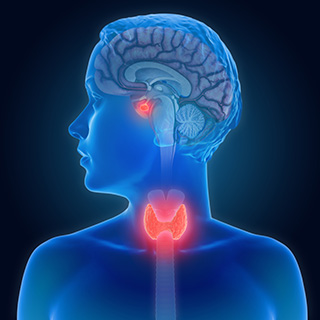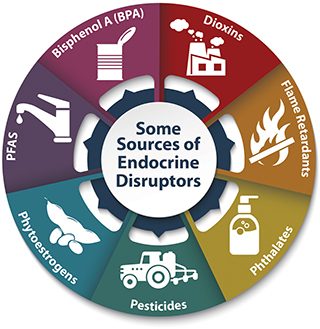Introduction
Endocrine Disruptors

Endocrine-disrupting chemicals (EDCs) are natural or human-made chemicals that may mimic, block, or interfere with the body’s hormones, which are part of the endocrine system. These chemicals are associated with a wide array of health issues.
The Endocrine System
Endocrine glands, distributed throughout the body, produce the hormones that act as signaling molecules after release into the circulatory system. The human body is dependent on hormones for a healthy endocrine system, which controls many biological processes like normal growth, fertility, and reproduction. Hormones act in extremely small amounts, and minor disruptions in those levels may cause significant developmental and biological effects.
How Do We Encounter These Chemicals?

Endocrine disruptors are found in many everyday products, including some cosmetics, food and beverage packaging, toys, carpet, and pesticides. Some chemicals that act as flame retardants may also be endocrine disruptors. Contact with these chemicals may occur through air, diet, skin, and water. EDCs cannot be completely avoided or removed; however, you can make informed choices to reduce exposure and risk of any potential health effects.
Chemicals That May Disrupt Your Endocrine System
According to the Endocrine Society, there are nearly 85,000 human-made chemicals in the world, and 1,000 or more of those could be endocrine disruptors, based on their unique properties. The following are among the most common and well-studied.
- Atrazine is one of the most commonly applied herbicides in the world, often used to control weeds in corn, sorghum, and sugarcane crops.
- Bisphenol A (BPA) is used to make polycarbonate plastics and epoxy resins. It is used in manufacturing, food packaging, toys, and other applications. BPA resins may be found in the lining of some canned foods and beverages.
- Dioxins are a byproduct of certain manufacturing processes, such as herbicide production and paper bleaching. They can be released into the air from waste burning and wildfires.
- Perchlorate is a colorless salt manufactured and used as an industrial chemical to make rockets, explosives, and fireworks, which can be found in some groundwater.
- Per- and polyfluoroalkyl substances (PFAS) are a large group of chemicals used widely in industrial applications, such as firefighting foam, nonstick pans, paper, and textile coatings.
- Phthalates are a large group of compounds used as liquid plasticizers. They are found in hundreds of products including some food packaging, cosmetics, fragrances, children’s toys, and medical device tubing. Cosmetics that may contain phthalates include nail polish, hair spray, aftershave lotion, cleanser, and shampoo.
- Phytoestrogens are naturally occurring substances with hormone-like activity found in some plants; they may have a similar effect to estrogen produced by the body. Soy foods, for example, contain phytoestrogens.
- Polybrominated diphenyl ethers (PBDE) are used to make flame retardants for products such as furniture foam and carpet.
- Polychlorinated biphenyls (PCBs) were used to make electrical equipment, such as transformers, and are in hydraulic fluids, heat transfer fluids, lubricants, and plasticizers. PCBs were mass-produced globally until they were banned in 1979.
- Triclosan is an ingredient that was previously added to some antimicrobial and personal care products, like liquid body wash and soaps.
How do people encounter endocrine-disrupting chemicals?
People may be exposed to endocrine disruptors through food and beverages consumed, pesticides applied, and cosmetics used. In essence, your contact with these chemicals may occur through diet, air, skin, and water.
Even low doses of endocrine-disrupting chemicals may be unsafe. The body’s normal endocrine functioning involves very small changes in hormone levels, yet we know even these small changes can cause significant developmental and biological effects. This observation leads scientists to think that endocrine-disrupting chemical exposures, even at low amounts, can alter the body’s sensitive systems and lead to health problems.

What is NIEHS Doing?
For more than three decades, NIEHS has been a pioneer in conducting research on the health effects of endocrine disruptors. NIEHS-supported research leads to a greater understanding of how endocrine-disrupting chemicals may harm our health and cause disease.
Fact Sheets
Endocrine Disruptors and Your Health
This work began with studies on the endocrine-disrupting effects of the drug diethylstilbestrol (DES). From 1940s through 1970s, DES was used to treat women with high-risk pregnancies, with the mistaken belief that it prevented miscarriage. In 1972, prenatal exposure to DES was linked to the development of a rare form of vaginal cancer in daughters whose mothers took DES, and with numerous noncancerous changes in both sons and daughters. NIEHS experiments on DES successfully replicated and predicted health problems, which was useful in discovering how DES may harm wellbeing.
NIEHS was involved in developing a consensus statement in 2019 on the key characteristics of endocrine-disrupting chemicals, which provides a framework to help scientists evaluate potential endocrine disruptors.
NIEHS leads cutting-edge research projects on endocrine disrupting chemicals to understand how they work and define their role in health and disease. Research areas in progress include:
- Developing new models and tools to better understand how endocrine disrupters work
- Developing and applying high throughout assays to identify substances with endocrine disrupting activity
- Conducting animal and human health research to define linkages between exposure to endocrine disrupters and health effects
- Developing new assessments and biomarkers of exposure and toxicity
- Identifying and developing new intervention and prevention strategies
Related work of the National Toxicology Program
In 2000, an independent panel of experts convened by NIEHS and the National Toxicology Program (NTP), which is housed at NIEHS, concluded there was credible evidence that very low doses of some hormone-like chemicals can adversely affect bodily functions in test animals.
NTP is evaluating endocrine disrupters including pesticides, perfluorinated chemicals, compounds that may replace BPA in the marketplace, and components of flame-retardants for how they may affect body tissues such as breast, uterus, fat cells, male reproductive tract, and liver. In addition, they conduct laboratory studies that help them prioritize endocrine disrupting chemicals for further toxicity testing.
NTP scientists collaborate with researchers from the U.S. Environmental Protection Agency (EPA) to develop and validate integrated, high throughput testing strategies to detect substances that could disrupt endocrine functions by interacting with the hormones estrogen and androgen. In addition, they created a comprehensive database from thousands of scientific studies on how different substances interact with hormones.
The multi-agency Tox 21 program, in which NIEHS participates, is developing and applying new models and tools using robotics to predict endocrine disrupting activity for environmental substances.
What has NIEHS discovered?
NIEHS-supported research has discovered links between endocrine-disrupting chemicals and the ways in which wellbeing may be harmed, as shown by the following examples:
- Attention. Attention-deficit/hyperactivity disorder (ADHD) is one of the most common childhood disorders, which can continue through adolescence and into adulthood. ADHD symptoms include difficulty staying focused, paying attention, and controlling behavior. Researchers reported in JAMA that ordinary exposure to certain phthalates, as found in urine samples, was associated with ADHD-related behaviors in adolescence. The drug DES may be linked to an increased chance of developing ADHD in the grandchildren of women who used it during pregnancy.
- Immunity. Children exposed to high levels of PFAS had a diminished immune response to vaccines.
- Metabolism. Long-term exposure to arsenic can disrupt metabolism, increasing the risk of diabetes and other metabolic disorders.
- Puberty. Chemicals in lavender oil and tea tree oil are potential endocrine disruptors. Researchers found that persistent exposure to lavender oil products is associated with premature breast development in girls, and abnormal breast development in boys.
- Reproduction. DES can cause epigenetic changes, altering the way genes are turned on and off, in reproductive organs of mice. The findings provide a possible explanation for how endocrine disruptors affect fertility and reproduction.
Further Reading
Stories from the Environmental Factor (NIEHS Newsletter)
- Personal Care Product Use During Puberty May Affect Breast Cancer Risk (April 2024)
- Phthalate Exposures Associated With High Numbers of Preterm Birth (April 2024)
- Phthalates Linked to Increased Rates of Preterm Birth Among Marginalized Groups (February 2024)
- Reducing Phthalates in Beauty Products May Lower Health Risks, Disparities(May 2023)
- New Tests of Endocrine-disrupting Chemicals Emerge From Interagency Effort(March 2023)
- On the Road Again: NIEHS Shines at the Endocrine Society’s Annual Conference(July 2022)
- Insight into Endocrine Disruptor Bisphenol a Advanced By NIEHS (November 2021)
- Precision Environmental Health Brings Nuance to Disease Prevention(February 2021)
Press Releases
- Preterm Birth More Likely With Exposure to Phthalates (July 11, 2022)
Podcasts
- Botanical Safety (2021)
- Hair Care and Black Women’s Health (2021)
Additional Resources
- What is Endocrine Disruption?, an informational website for consumers created by the U.S. Environmental Protection Agency
Related Health Topics
This content is available to use on your website.
Please visit NIEHS Syndication to get started.


